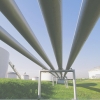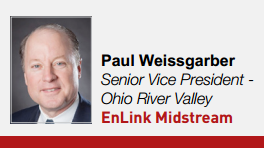RL Blogs

By American Business Conferences
Oct 05, 2014Interview with Paul Weissgarber on the future of North American condensate markets. |
||
of the day, we are stabilizing condensate to get it to market.
We think it’s important to start with the market piece and then work backwards into exploring the different options that are available for stabilizing condensate. We’ll then discuss the trade offs between the various options.
2. Why has EnLink decided to invest $250 million in a new condensate pipeline and processing facility in Ohio?
EnLink is a midstream company, so we’re in the business of connecting supplies to market, it’s what we do every day. As a company, we talk about how we connect energy to life; midstream companies are a very critical part of the puzzle in how you connect energy to life.
We already have an existing pipeline system in Ohio, and we saw this as a great opportunity to further link these new condensate supplies from the Utica and Western Marcellus to market. Both of these shale plays are emerging as very prolific condensate producers, and the industry needs it’s midstream infrastructure to effectively gather and then move those new volumes to market.
3. What are the major challenges impacting the condensate market in your view?
A key challenge right now is just understanding the quality of the product that will get produced. We’re seeing emerging grades of condensate with different properties, so we’re still defining what the end product will really look like, and how many different grades there will there be as far as aggregating the supply goes.
In the Utica and Marcellus, we don’t have enough history to know exactly what the products can look like from different sub regions in that area; continued development will provide a much clearer picture. There are trade offs with respect to segregation of the different grades of condensate and how much you accumulate and aggregate into a single grade, or whether it makes more sense to segregate different grades of condensate in the region.
Some of that supply picture is coming into clearer focus as more wells are coming online. Another major challenge will be the lack of the local markets to absorb the supply, which will mean that you need to officially export product from the region.
4. Which areas require more infrastructure in your view?
We are at an unprecedented time in the energy business in that every piece of the energy infrastructure is requiring additional investment. Billions of dollars are needed to be invested across the board, so we are seeing big announcements right now with these intra-regional inter state natural gas pipelines.
We have just finished a very large project to take natural gas liquid from the upper Texas Gulf Coast over to Louisiana where the NGL processing, treating capacities are available to take advantage of the higher natural gas liquids production here in North America. Therefore, we see projects being needed across the entire energy value chain and we’d be hard pressed to say this basin, or that segment has the bigger need.
5. How do you see the future condensate export market developing? What are the most significant markets?
One of the nice things about the Utica and Western Marcellus is that we’re smack-dab in the middle of the country. We’re very blessed that we have a very navigable waterway there - the Ohio River, which we see as being the most efficient way to export product out of the region.
We’re doing that today through our barge facility and continue to see the Gulf coast as being a very desirable market area for the product, easily reached via barge. We’re also moving product out of the area via rail, which we think is another great option because of the flexibility in where you can get the cars to. Barge is much more cost efficient per mile, but unfortunately the river may not run exactly where you need it to.
We are using pipe to aggregate to these market outlets. It is difficult to see that the volume produced in the mid-west will warrant laying an intra-regional condensate pipeline to the gulf coast, and the other options are still very cost effective.
We have a lot of interest in the international markets right now, particularly Singapore and South Korea, and we actually see the most likely exportation destination as South America. I am aware that everybody is closely following the exportation of condensate to Asia Pacific, and the type of stabilizers we have running today.
EnLink is the largest stabilizer of condensate in the region today and we recently announced expansion that will further increase our market leadership in that area. After we’ve taken this condensate through our stabilization facilities, it can be certified for exportation to international markets. I read the other day that they’ll have as much as a million barrels a day of condensate processing capacity, so we see a natural linkage to those international markets.
6. Where do you see the most significant domestic markets for condensate? Diluent or refining?
The most natural markets are the local refineries, which can augment their existing crude slate with condensate. A typical refining process has as much as 10% of their inlet crude slate that they could see using condensate and we certainly see them plugging that into their crude slates. Blending in the Gulf Coast is a potential market. Potential exportation.
We still see the diluent market as being very highly dependent on the quality of the condensate that emerges from the region. The market generally likes to use ultra light condensate and it remains to be seen matching the right barrels to that particular need.
Many times, people talk about condensate going into the diluent market. Part of the challenge you have is a misunderstanding when people use the word condensate. Sometimes what people are referring to are plant condensates- really natural gasoline.
A product made as a result of processing a natural gas a which natural gas stream in like a cryogenic processing plant, rather than what I’m referring to here, which is field condensate which is produced at the well in association with the natural gas.
7. What are you most looking forward to at the conference? Who do you want to meet and hear from?
At EnLink, one of our core values is to strive for excellence, and one way we do that is by actively engaging in the industry. We view attendance at a conference like this as an opportunity that really allows us to learn from others as well as further enhance our capabilities.
Our view is that you can learn something from everybody, so we really look forward to participating. We like to hear other people’s stories and look for opportunities that we could collaborate on together.
8. Why is it important for EnLink to speak at the condensate marketing congress? and why should other condensate professionals attend?
We have a big stake in the condensate market. Our operation in the Utica and Western Marcellus operates the largest truck fleet in the region and we have the most condensate stabilization assets and operations today and will have in the future, having recently announced expansion through Howard Energy.
We are actively looking at projects in other places around condensate, so we see that there’s going to be ample opportunities as a midstream company to support producers and end users in aggregating and moving condensate to market. So we see ourselves being a very natural and valuable participant.
Steel sharpens steel, and attending an event like this just allows everybody to be that much better if you come with an open mind and willingness to learn. I’d encourage folks to try to spend more time listening, and less time talking.
There is a lot to learn from our peers in the business, and as an industry, we have a responsibility to be speaking more with one voice. In some communities, there is a lot of misinformation, for example this discussion about the volatility of products and movement.
Our industry always has safety at the forefront, it’s part of everything we do every day. The more we can get together to talk about these issues and work together to maintain our high safety performance, the better. These meetings are also important to work externally to educate and help others understand how this shale revolution is changing the face of North America. There are a lot of great things that are happening in our country and in Canada, as a result of the efforts of so many fine professionals that work in this industry every day.
Paul Weissgarber will be speaking at the Condensate Markets, Export & Takeaway Capacity (October 22-23, Houston) on day 1:
| ||
|
|










